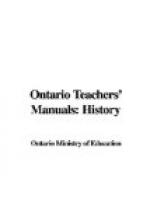(Several suggestions were made. “We would have to keep everything till the next summer.” “We would have to use ice-boats.” Objections were raised to these methods to show that they were impossible. Finally one pupil thought that we could send our freight through the United States.)
T.—Well,
why did the people not continue doing that, instead
of
wanting to build a railway
of their own?
P.—The United States would likely make them pay for doing it.
T.—Let me explain about that. In 1854, a treaty had been made between Canada and the United States, called the Reciprocity Treaty, by which the two countries exchanged their goods freely. This treaty was ended in 1866, and the people of Canada had to depend more on themselves. Besides, there was a good deal of trouble between Britain and the United States, arising out of the Civil War in the latter country, which had just ended. (The pupils are told here about the “Trent” and “Alabama” affairs, and the Fenian raids of 1866.) The people at that time were afraid that there might be war between the two countries and, of course, that would bring Canada into the trouble. Do you see now why a railway was needed from Quebec to Halifax?
P.—Because
there was danger of war, and because the United
States might interfere
with Canadian trade.
T.—There were both military and commercial reasons. We have found now why the road was to run from Halifax to Quebec, and why it had to be built at that time. The next thing to find out is—Where it was to be built. If you were a railway contractor and had to build the road without thinking of anything but getting it done, what route would you be likely to follow?
P.—I think I should take the shortest way.
T.—Where would the road go then?
(Have a pupil place a ruler on the map from Quebec to Halifax.)
Tell where it would run.
P.—Through
Quebec Province, the State of Maine, New Brunswick,
and Nova Scotia.
T.—Would
the people build it along that line? Don’t
forget the
reasons for building
it at all.
P.—They
wouldn’t go through the State of Maine, because
that is
in the United States.
T.—What is the next way they might think of?
P.—The next shortest way so as to keep in Canada.
T.—Where would that be? (Pupil comes up and tells from the map.)
P.—From
Quebec city through Quebec, along the edge of Maine,
into New Brunswick and
Nova Scotia.
T.—Would they take that way?
P.—No, because it is too near the border of the United States.
T.—Why do you say “too near”?




